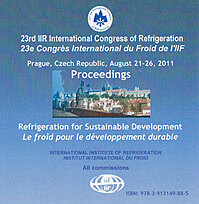
Document IIF
Analyse thermodynamique d'un système frigorifique à cascade au R744-R717 comparé à un système biétagé au R404A.
Thermodynamic analysis of a R744-R717 cascade refrigeration system compared with a R404A two-stage system.
Numéro : pap. ID: 110
Auteurs : MESSINEO A., PANNO G.
Résumé
In this study is presented a thermodynamic analysis of a cascade refrigeration system using as refrigerant carbon dioxide in low-temperature circuit and ammonia in high-temperature circuit. The operating parameters considered in this paper include condensing, evaporating, superheating and subcooling temperatures in the ammonia (R717) high-temperature circuit and in the carbon dioxide (R744) lowtemperature circuit. Diagrams of COP versus operating parameters have been obtained. In addition, values for R744-R717 cascade refrigeration system are compared with the values obtained for a partial injection two-stage refrigeration system using the synthetic refrigerant R404A, a nearly azeotropic blend, specially used for commercial refrigeration. Results show that a carbon dioxide-ammonia cascade refrigeration system is an interesting alternative to R404A two-stage refrigeration system for low evaporating temperatures (–30 °C ÷ –50°C) in commercial refrigeration for energy, security and environmental reasons.
Documents disponibles
Format PDF
Pages : 9 p.
Disponible
Prix public
20 €
Prix membre*
Gratuit
* meilleur tarif applicable selon le type d'adhésion (voir le détail des avantages des adhésions individuelles et collectives)
Détails
- Titre original : Thermodynamic analysis of a R744-R717 cascade refrigeration system compared with a R404A two-stage system.
- Identifiant de la fiche : 30001552
- Langues : Anglais
- Source : Proceedings of the 23rd IIR International Congress of Refrigeration: Prague, Czech Republic, August 21-26, 2011. Overarching theme: Refrigeration for Sustainable Development.
- Date d'édition : 21/08/2011
Liens
Voir d'autres communications du même compte rendu (569)
Voir le compte rendu de la conférence
Indexation
-
Evolution of CO2 systems design based on practi...
- Auteurs : MATTHIESEN H. O., MADSEN K. B., MIKHAILOV A.
- Date : 12/04/2010
- Langues : Anglais
- Source : 9th IIR-Gustav Lorentzen Conference on Natural Working Fluids (GL2010). Proceedings. Sydney, Australia, April 12-14, 2010.
- Formats : PDF
Voir la fiche
-
Implementation of CO2/propane walk-in storage r...
- Auteurs : MADSEN K. B., VILLUMSEN J., NIELSEN J.
- Date : 17/08/2003
- Langues : Anglais
- Source : 21st IIR International Congress of Refrigeration: Serving the Needs of Mankind.
- Formats : PDF
Voir la fiche
-
Experimental investigation of NH3/CO2 cascade s...
- Auteurs : SAWALHA S., PERALES CABREJAS C., LIKITTHAMMANIT M., et al.
- Date : 21/08/2007
- Langues : Anglais
- Source : ICR 2007. Refrigeration Creates the Future. Proceedings of the 22nd IIR International Congress of Refrigeration.
- Formats : PDF
Voir la fiche
-
NH3/CO2 supermarket refrigeration system with C...
- Auteurs : RIESSEN G. J. van
- Date : 01/08/2004
- Langues : Anglais
- Source : Natural Working Fluids 2004: 6th IIR-Gustav Lorentzen Conference
- Formats : PDF
Voir la fiche
-
Energy efficiency comparison of the CO2 cascade...
- Auteurs : SILVA A., ALMEIDA E., BANDARRA FILHO E. P.
- Date : 12/04/2010
- Langues : Anglais
- Source : 9th IIR-Gustav Lorentzen Conference on Natural Working Fluids (GL2010). Proceedings. Sydney, Australia, April 12-14, 2010.
- Formats : PDF
Voir la fiche
